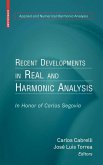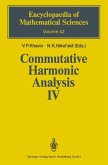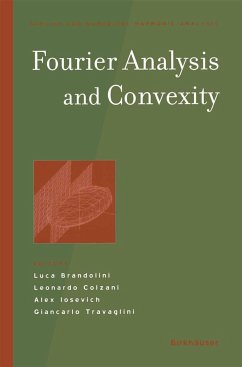This text introduces modern harmonic analysis in the context in which it is actually applied, in particular through complex function theory and partial differential equations. Topics progress from harmonic analysis to Fourier transform to Heisenberg analysis.
Harmonic analysis is a venerable part of modern mathematics. Its roots began, perhaps, with late eighteenth-century discussions of the wave equation. Using the method of separation of variables, it was realized that the equation could be solved with a data function of the form?(x)= sin jx for j? Z.Itwasnaturaltoask, using the philosophy of superposition, whether the equation could then be solved with data on the interval [0,?] consisting of a nite linear combinationof the sin jx. With an af rmative answer to that question, one is led to ask about in?nite linear combinations. This was an interesting venue in which physical reasoning interacted with mathematical reasoning. Physical intuition certainly suggests that any continuous function? can be a data function for the wave equation. So one is led to ask whether any continuous? can be expressed as an (in nite) superposition of sine functions. Thus was born the fundamental question of Fourier series. No less an eminence gris than Leonhard Euler argued against the proposition.
Harmonic analysis is a venerable part of modern mathematics. Its roots began, perhaps, with late eighteenth-century discussions of the wave equation. Using the method of separation of variables, it was realized that the equation could be solved with a data function of the form?(x)= sin jx for j? Z.Itwasnaturaltoask, using the philosophy of superposition, whether the equation could then be solved with data on the interval [0,?] consisting of a nite linear combinationof the sin jx. With an af rmative answer to that question, one is led to ask about in?nite linear combinations. This was an interesting venue in which physical reasoning interacted with mathematical reasoning. Physical intuition certainly suggests that any continuous function? can be a data function for the wave equation. So one is led to ask whether any continuous? can be expressed as an (in nite) superposition of sine functions. Thus was born the fundamental question of Fourier series. No less an eminence gris than Leonhard Euler argued against the proposition.
From the reviews:
"This is an ambitious introduction to a particular direction in modern harmonic analysis. It presents harmonic analysis in vitro - in a context in which it is actually applied complex variables and partial differential equations. This will make the learning experience more meaningful for graduate students who are just beginning to forge a path of research." (Vasily A. Chernecky, Zentralblatt MATH, Vol. 1171, 2009)
"Writing a 350 page account on harmonic analysis ... is no easy task and making the presentation suitable for graduate students even less so. ... it is indeed the purpose of the book under review ... . Krantz has done an admirable job in condensing the ideas of Stein's tract into a highly readily text suitable for a wide variety of readers. ... It is done with such an enthusiasm ... that even seasoned mathematicians should be able to enjoy the book." (Troels Roussau Johansen, Mathematical Reviews, Issue 2011 a)
"The text is very well organized: each chapter begins with an introductory Prologue, each section with a Capsule giving a quick preview of the material, and each key theorem is preceded by a Prelude providing motivation and putting the result in an adequate context. ... The book will be useful for advanced courses on harmonic analysis, singular integrals, as well as reference text for researchers in various domains of analysis, both pure and applied." (Gabriela Kohr, Studia Universitatis Babes-Bolyai, Mathematica, Vol. LV (4), December, 2010)
"This is an ambitious introduction to a particular direction in modern harmonic analysis. It presents harmonic analysis in vitro - in a context in which it is actually applied complex variables and partial differential equations. This will make the learning experience more meaningful for graduate students who are just beginning to forge a path of research." (Vasily A. Chernecky, Zentralblatt MATH, Vol. 1171, 2009)
"Writing a 350 page account on harmonic analysis ... is no easy task and making the presentation suitable for graduate students even less so. ... it is indeed the purpose of the book under review ... . Krantz has done an admirable job in condensing the ideas of Stein's tract into a highly readily text suitable for a wide variety of readers. ... It is done with such an enthusiasm ... that even seasoned mathematicians should be able to enjoy the book." (Troels Roussau Johansen, Mathematical Reviews, Issue 2011 a)
"The text is very well organized: each chapter begins with an introductory Prologue, each section with a Capsule giving a quick preview of the material, and each key theorem is preceded by a Prelude providing motivation and putting the result in an adequate context. ... The book will be useful for advanced courses on harmonic analysis, singular integrals, as well as reference text for researchers in various domains of analysis, both pure and applied." (Gabriela Kohr, Studia Universitatis Babes-Bolyai, Mathematica, Vol. LV (4), December, 2010)








